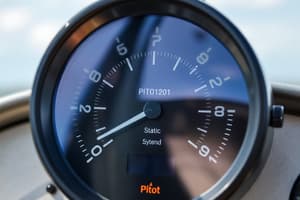Podcast
Questions and Answers
What does the pitot air system primarily measure?
What does the pitot air system primarily measure?
- Airspeed (correct)
- Vertical speed
- Ambient temperature
- Altitude
What consequence can result from a blocked pitot head?
What consequence can result from a blocked pitot head?
- Erratic or zero instrument readings (correct)
- Improved altitude stability
- Stable airspeed readings
- Increased engine power
What is the function of the static air system?
What is the function of the static air system?
- To generate cabin pressure
- To provide airspeed readings
- To measure engine temperature
- To measure altitude and vertical speed (correct)
Where is the alternate static air source located?
Where is the alternate static air source located?
What is the role of the drain valves in the pitot and static systems?
What is the role of the drain valves in the pitot and static systems?
Flashcards are hidden until you start studying
Study Notes
Pitot Air System
- Comprises a pitot mast located underneath the left wing, along with associated plumbing.
- Impact air pressure enters through the pitot inlet and travels via hose and tubing to the airspeed indicator on the instrument panel.
- Can also connect to the Avidyne Entegra PFD or Garmin Air Data Computer for enhanced displays.
- Partial or complete blockage of the pitot head leads to erratic readings or zero instrument values.
Static Air System
- Features a static port on the underside of the pitot-static mast.
- The static port connects to the airspeed indicator, altimeter, and vertical speed indicator through hose and tubing.
- If installed, also connects to the Avidyne Entegra PFD or Garmin Air Data Computer.
- Equipped with an alternate static air source below the instrument panel; includes a shutoff valve to control usage.
Drainage System
- Pitot and static lines are drained separately using designated drain valves.
- Located on the left lower side of the fuselage interior to facilitate maintenance and safety.
Studying That Suits You
Use AI to generate personalized quizzes and flashcards to suit your learning preferences.




